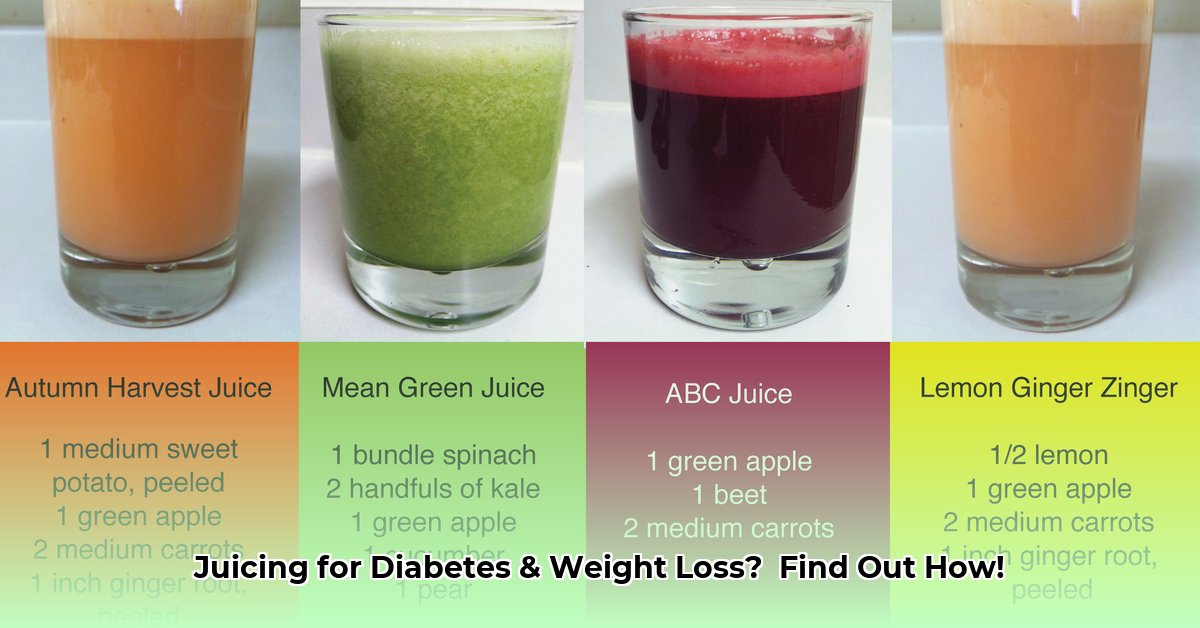
Juicing for Diabetes and Weight Management: A Comprehensive Guide
Juicing can be a valuable tool in managing diabetes and supporting weight loss, but it's crucial to understand its role as a complement to, not a replacement for, a comprehensive diabetes management plan. This guide provides actionable recipes and strategies for safe and effective juicing, empowering you to make informed choices. Remember, always consult your doctor or a registered dietitian before making significant dietary changes, especially if you have diabetes or other health conditions.
Understanding the Glycemic Index (GI)
The glycemic index (GI) measures how quickly a carbohydrate-containing food raises your blood sugar levels. Low-GI foods cause a gradual increase, preventing sharp spikes, while high-GI foods lead to rapid rises followed by potential crashes. For diabetics, managing these blood sugar fluctuations is critical for long-term health. Choosing low-GI ingredients for your juices is paramount.
| Food Category | High GI Examples | Low GI Examples |
|---|---|---|
| Fruits | Watermelon, Mango, Pineapple | Berries (strawberries, blueberries, raspberries), Kiwi, Apples, Grapefruit |
| Vegetables | Corn, Potatoes, Pumpkin | Leafy Greens (spinach, kale), Carrots, Celery, Broccoli, Peppers |
Recipe Selection Criteria: Building Your Perfect Juice
When selecting ingredients, prioritize these factors:
- Low Glycemic Index (GI): Opt for fruits and vegetables with a low GI to minimize blood sugar spikes.
- Fiber Content: Fiber slows sugar absorption, promoting stable blood sugar levels. Choose fibrous vegetables like celery and leafy greens.
- Nutrient Density: Aim for nutrient-rich ingredients packed with vitamins, minerals, and antioxidants. Leafy greens and berries are excellent choices.
Delicious and Healthy Juicing Recipes
The following recipes offer a starting point. Always monitor your blood sugar after consuming any juice to identify how your body responds. Portion control is paramount.
Recipe 1: Green Goodness Powerhouse
- 1 cup spinach (low GI, high in iron and vitamins)
- ½ cup kale (low GI, high in vitamins A, K, and C)
- ½ cucumber (low GI, hydrating and refreshing)
- ½ green apple (medium GI, adds sweetness – use sparingly)
- 1 stalk celery (low GI, adds fiber and crunch)
Approximate Carbohydrates: ~15g (This is an estimate; the exact amount may vary based on the specific ingredients and their quantity.)
Recipe 2: Vibrant Beet Blast
- 1 medium beet (medium GI, rich in nitrates – use in moderation)
- ½ cup carrots (low GI, good source of beta-carotene and fiber)
- ½ orange (medium GI, adds Vitamin C and sweetness – use in moderation)
- ¼ lemon (low GI, adds zesty flavor and Vitamin C)
Approximate Carbohydrates: ~20g (This is an estimate and can vary.)
Recipe 3: Berrylicious Bliss
- 1 cup mixed berries (low GI, antioxidants galore!)
- ½ cup chopped cucumber (low GI, hydrating and refreshing)
Approximate Carbohydrates: ~18g (This is an approximate value and can change based on the specific berries used).
Recipe Variations: Experiment with substituting ingredients using the GI chart as your guide.
Precautions and Safety: Prioritizing Your Well-being
- Consult Your Doctor: Consult your physician or a registered dietitian before starting a juicing regimen, especially if you have diabetes or are taking medications.
- Monitor Blood Sugar: Regularly check your blood sugar levels before and after drinking juice to understand your body's response.
- Portion Control: Avoid overconsumption, as excessive juice intake can still negatively impact blood sugar levels.
- Medication Interactions: Some medications may interact with certain juices. Always discuss dietary changes with your pharmacist or doctor.
Tips for Juicing Success
- Juice Fresh: For optimal nutrient retention, juice fresh ingredients whenever possible.
- Proper Storage: Store juices in airtight containers in the refrigerator and consume within 24 hours.
- Balanced Meal Plan: Integrate juices into a balanced diet, not as a meal replacement.
- Regular Exercise: Combine juicing with regular physical activity for enhanced diabetes management and weight loss.
Conclusion: A Holistic Approach to Health
Juicing can be a part of a healthy lifestyle for individuals with diabetes, but it must be part of a broader strategy that includes medical advice, balanced nutrition, and regular exercise. Remember, consistent monitoring and open communication with your healthcare team are paramount to achieving lasting health improvements. Don't hesitate to seek personalized guidance to create a juicing plan that specifically addresses your individual needs and dietary requirements.